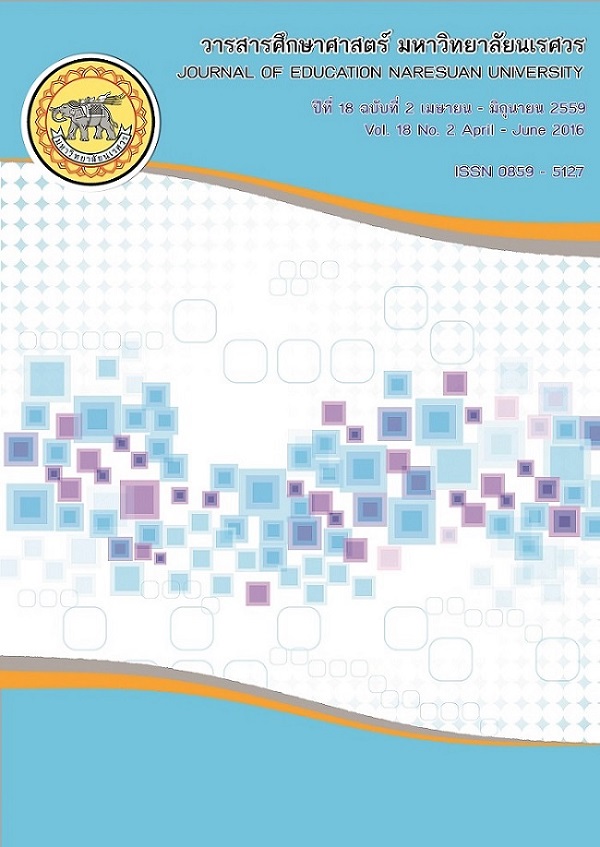การพัฒนารูปแบบการจัดการเรียนรู้วิชาชีววิทยาแบบผสมผสาน โดยใช้แหล่งข้อมูลเป็นหลัก เพื่อส่งเสริมความใฝ่เรียนรู้ สำหรับนักเรียนชั้นมัธยมศึกษาตอนปลาย
Main Article Content
Abstract
บทคัดย่อ
การวิจัยครั้งนี้มีวัตถุประสงค์ 1) เพื่อสร้างและตรวจสอบคุณภาพของรูปแบบการจัดการเรียนรู้วิชาชีววิทยาแบบผสมผสานโดยใช้แหล่งข้อมูลเป็นหลักเพื่อส่งเสริมความใฝ่เรียนรู้ สำหรับนักเรียนชั้นมัธยมศึกษาตอนปลาย 2) เพื่อใช้และศึกษาผลการใช้รูปแบบการจัดการเรียนรู้วิชาชีววิทยาแบบผสมผสานโดยใช้แหล่งข้อมูลเป็นหลักเพื่อส่งเสริมความใฝ่เรียนรู้ สำหรับนักเรียนชั้นมัธยมศึกษาตอนปลาย 3) เพื่อศึกษาความพึงพอใจของนักเรียนที่มีต่อการจัดการเรียนการสอนด้วยรูปแบบการจัดการเรียนรู้วิชาชีววิทยาแบบผสมผสานโดยใช้แหล่งข้อมูลเป็นหลักเพื่อส่งเสริมความใฝ่เรียนรู้ สำหรับนักเรียนชั้นมัธยมศึกษาตอนปลาย
การดำเนินการวิจัยครั้งนี้ ดำเนินการเป็น 3 ขั้นตอน คือ 1) ขั้นการสร้างและตรวจสอบคุณภาพรูปแบบการจัดการเรียนรู้และเอกสารประกอบการใช้รูปแบบ โดยผู้ทรงคุณวุฒิ พบว่ารูปแบบและเอกสารประกอบการใช้รูปแบบการจัดการเรียนรู้ มีความเหมาะสมระดับมากที่สุด และนำร่องทดลองสอนตามรูปแบบเพื่อพิจารณาความเป็นไปได้กับนักเรียนชั้นมัธยมศึกษาปีที่ 4 โรงเรียนวังแขมวิทยาคม จังหวัดกำแพงเพชร จำนวน 20 คน พบว่าค่าดัชนีประสิทธิผลผ่านเกณฑ์สูงกว่าร้อยละ 50 2) ขั้นการใช้และศึกษาผลการใช้รูปแบบการจัดการเรียนรู้ กับนักเรียนชั้นมัธยมศึกษาปีที่ 4 โรงเรียนวังแขมวิทยาคม จำนวน 33 คน เครื่องมือที่ใช้ในการวิจัยครั้งนี้ ได้แก่ แบบวัดความใฝ่เรียนรู้ ที่มีค่า IOC ระว่าง 0.80-1.00 ค่าอำนาจจำแนกระหว่าง 0.27-0.89 และค่าความเชื่อมั่น 0.81 แบบสังเกตพฤติกรรมความใฝ่เรียนรู้มีค่า IOC เท่ากับ 1.00 ทุกข้อ และมีความเชื่อมั่นระหว่างผู้วิจัยและผู้ช่วยผู้วิจัย เท่ากับ 0.91 และ0.92 และแบบวัดผลสัมฤทธิ์ทางการเรียน มีค่า IOC ระหว่าง 0.80-1.00 ค่าอำนาจจำแนกระหว่าง 0.30-0.59 และค่าความเชื่อมั่น 0.91 และ 3) ขั้นการประเมินความพึงพอใจของนักเรียนที่มีต่อการเรียนด้วยรูปแบบการจัดการเรียนที่พัฒนาขึ้น เครื่องมือที่ใช้ในการวิจัย ได้แก่ แบบประเมินความพึงพอใจที่มีต่อการเรียนการสอน ในด้านปัจจัยนำเข้า กระบวนการ และผลผลิต ที่มีค่า IOC ระหว่าง 0.60-1.00 ค่าความเชื่อมั่น 0.88
ผลการวิจัย พบว่า
1. รูปแบบการจัดการเรียนรู้ที่พัฒนาขึ้นมีองค์ประกอบ ดังนี้ 1) หลักการ 2) วัตถุประสงค์
3) เนื้อหา 4) ขั้นการจัดการเรียนรู้ และ 5) การวัดผลและประเมินผล และในขั้นการจัดการเรียนรู้ที่สร้างขึ้นมีชื่อว่า ECACCE MODEL มีขั้นตอนการจัดการเรียนรู้ ดังนี้ 1) ขั้นเร้าความสนใจ (Excite interesting) 2) ขั้นใส่ใจร่วมวางแผน (Care planning) 3) ขั้นกระตือรือร้นในการเรียน (Active learning) 4) ขั้นเชื่อมโยงเครือข่ายและสร้างองค์ความรู้ (Connection and Construction) 5) ขั้นสร้างสรรค์นำเสนอผลงาน (Creative presentation) และ 6) ขั้นประเมินผล (Evaluation) ผลการตรวจสอบโดยผู้ทรงคุณวุฒิ พบว่ารูปแบบการจัดการเรียนรู้ที่พัฒนาขึ้นมีความเหมาะสมในระดับมากที่สุด
2. นักเรียนมีความใฝ่เรียนรู้หลังเรียนสูงกว่าก่อนเรียนอย่างมีนัยสำคัญทางสถิติที่ระดับ .05 และ มีพฤติกรรมความใฝ่เรียนรู้ในระดับดี
3. นักเรียนมีผลสัมฤทธิ์ทางการเรียนหลังเรียนสูงกว่าก่อนเรียนอย่างมีนัยสำคัญทางสถิติที่ระดับ .05
4. นักเรียนมีความพึงพอใจต่อการเรียนด้วยรูปแบบการจัดการเรียนรู้วิชาชีววิทยาแบบผสมผสาน โดยใช้แหล่งข้อมูลเป็นหลัก เพื่อส่งเสริมความใฝ่เรียนรู้สำหรับนักเรียนชั้นมัธยมศึกษาตอนปลาย ภาพรวมอยู่ในระดับมากที่สุด และเมื่อพิจารณาเป็นรายด้าน พบว่า ด้านปัจจัยนำเข้าในระดับมาก (= 4.48, S.D. = 0.32) ด้านกระบวนการในระดับมากที่สุด (
= 4.58, S.D. = 0.28) และด้านผลผลิตในระดับมาก
(= 4.35, S.D. = 0.46)
คำสำคัญ: รูปแบบการจัดการเรียนรู้, การจัดการเรียนรู้แบบผสมผสาน, การจัดการเรียนรู้โดยใช้แหล่งข้อมูลเป็นหลัก, ความใฝ่เรียนรู้
A DEVELOPMENT OF BLENDED LEARNING MANAGEMENT MODEL IN BIOLOGY USING RESOURCE BASED LEARNING TO ENHANCE LEARNING AVIDITY FOR HIGH SCHOOL STUDENTS
The purposes of this study were: 1) to construct and examine the quality of the blended learning management model in biology using resource based learning to enhance learning avidity for high school students, 2) to use and to implement blended learning management model in biology using resource based learning to enhance learning avidity for high school students, and 3) to study the students’ satisfaction on this learning model.
This study comprised of three steps which were 1) constructing the learning model and supplementary learning materials, having the experts examined quality was at the highest level and then conducting a pilot study among 20 Mattayomsuksa 4 students at Wangkhaem Wittayakom school, Kamphaengphet it found that the effectiveness index passed above 50 percent, 2) using and implementing the learning model with 33 mattayomsuksa 4 students at Wangkhaem Wittayakom school the research instrument were learning avidity test, that had the index of congruence at 0.80-1.00, discriminating ranging at 0.27-0.89 and reliability at 0.81, learning avidity observation form all had the index of congruence at 1.00 and reliability at between the author and co-author was at 0.91 and 0.92 and achievement test had the index of congruence at 0.80-1.00,discriminating ranging at 0.30-0.59 and reliability at 0.91, and
3) evaluating students’ satisfaction questionnaire who passed this learning model that the instrument on input process and output had index of congruence at 0.60-1.00 and reliability at 0.88.
The results of this study are as follows;
1. The learning model consisted of 1) principles, 2) objectives, 3) contents,
4) instructional processes, and 5) measurements and evaluations. The instructional processes was ECACCE MODEL that consists of 6 steps 1) Excite interesting, 2) Care planning,
3) Active learning, 4) Connection and construction, 5) Creative Presentation, and 6) Evaluation. The model was verified by the experts and it was found to be appropriate at the highest level.
2. The post – test of students‘ learning avidity was higher than their pre – test with statistically significance at .05 and learning avidity behaviors were at high level.
3. The students’ achievement scores after learning were higher than before learning with statistically significance at .05.
4. The level of students’ satisfaction on the blended learning management model in biology using resource based learning to enhance learning avidity for high school students were at highest level. It was found that the input aspect was at high level, the process aspect was at highest level and the output aspect was at high level.
Keywords: Learning Model, Blended Learning, Resource Based Learning, Learning Avidity
Article Details
The owner of the article does not copy or violate any of its copyright. If any copyright infringement occurs or prosecution, in any case, the Editorial Board is not involved in all the rights to the owner of the article to be performed.


